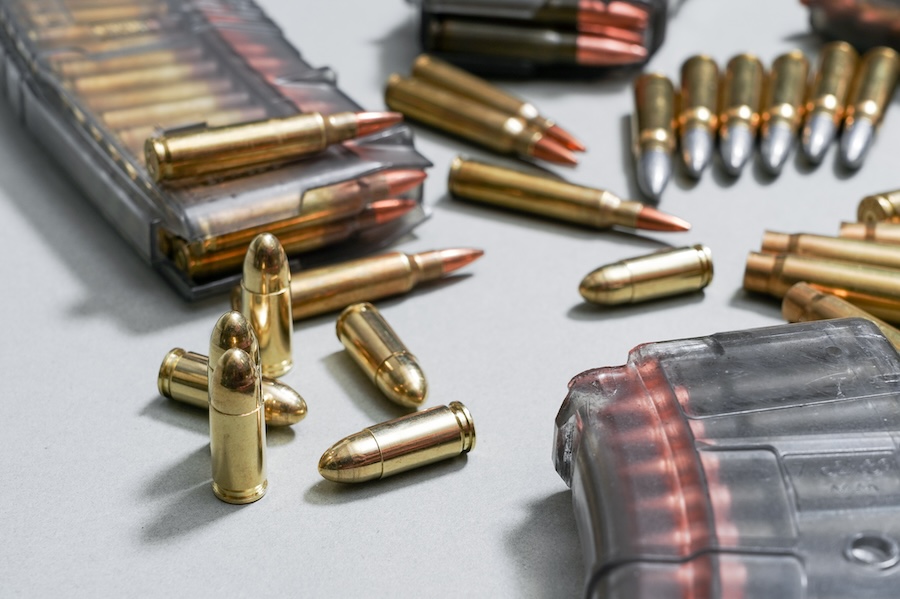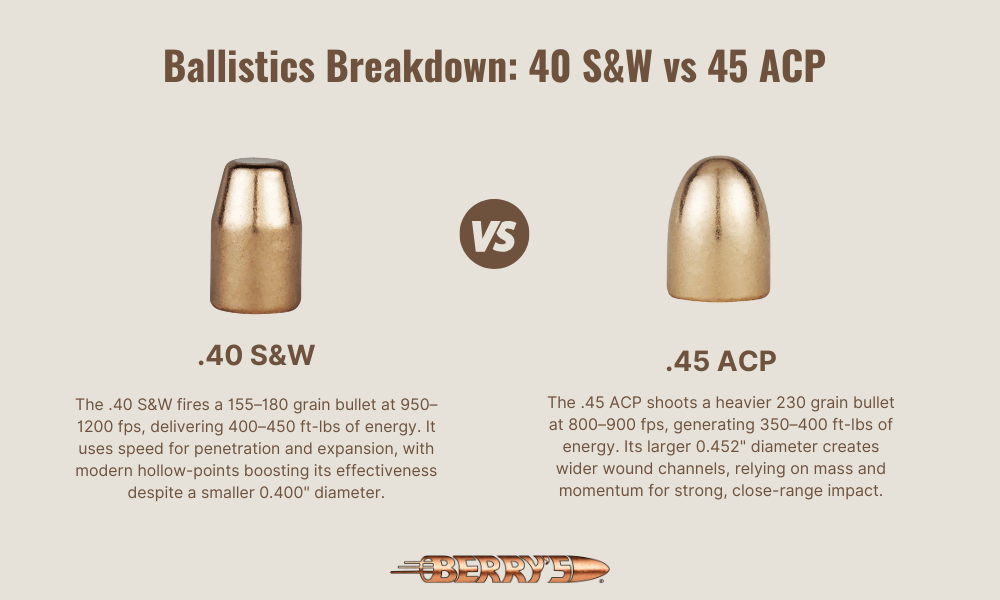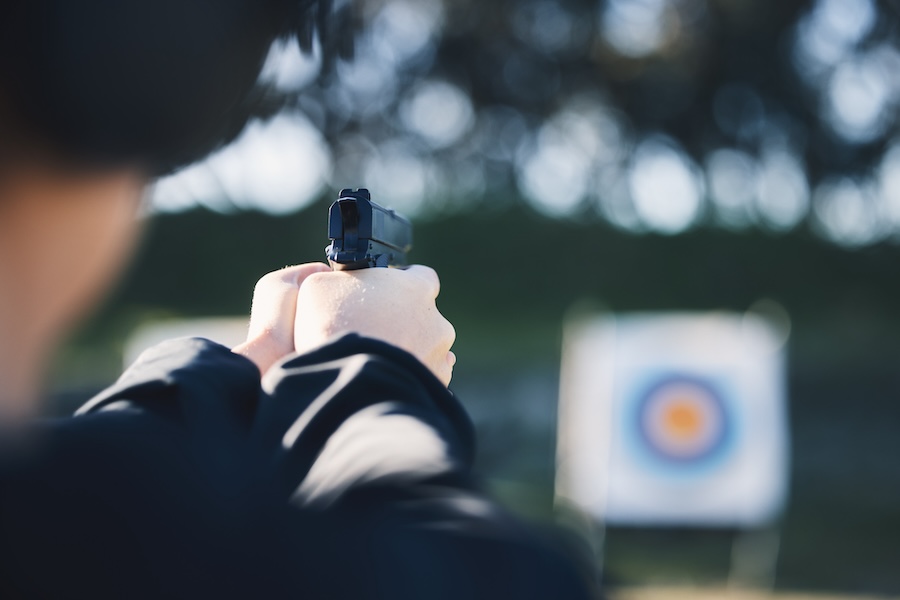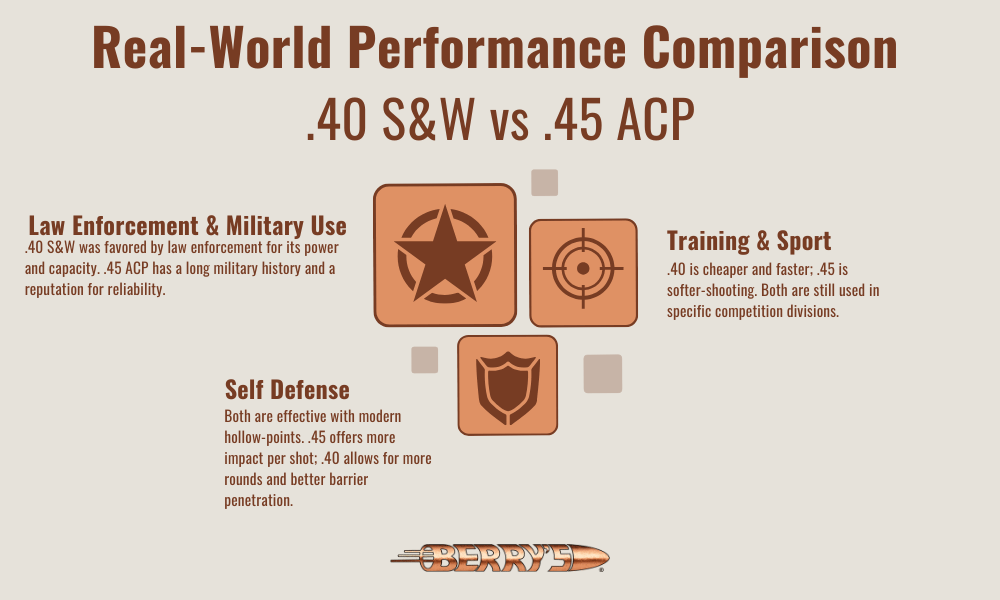Your cart is currently empty!

40 vs 45: The Complete Cartridge Comparison
Table of Contents:
The Short Answer: The .45 ACP delivers a heavier 230 grain bullet with excellent stopping power and less recoil, making it ideal for shooters who prioritize knock-down power and comfortable shooting. The .40 S&W offers higher velocity with a lighter bullet and higher magazine capacity, explaining why law enforcement agencies widely adopted this caliber for years.
At the end of the day, which caliber you choose comes down to your priorities. Both cartridges excel in personal defense situations, but understanding their differences will help you make the right choice. Let’s dive deeper into what separates these two legendary calibers and discover which one matches your shooting needs.

Ballistics Performance: Where Numbers Tell the Story
When comparing bullet performance, the math doesn’t lie. These two cartridges take distinctly different approaches to delivering terminal effectiveness.
Velocity and Energy Breakdown
The .40 S&W generates significantly higher velocity than its .45 ACP counterpart. A typical .40 S&W round pushes a 155-180 grain bullet to muzzle velocity ranges of 950-1200 feet per second, while the .45 ACP launches its heavier 230 grain bullet at a more modest 800-900 fps. This velocity advantage translates to different kinetic energy profiles that affect real-world performance.
Muzzle energy calculations reveal interesting trade-offs. The .40 S&W’s higher velocity often produces comparable muzzle energy to the .45 ACP despite using a lighter bullet. A 180-grain .40 S&W round typically generates around 400-450 foot-pounds of energy, while a 230-grain .45 ACP produces approximately 350-400 foot-pounds. The energy delivery differs significantly, the .40 S&W transfers its energy through velocity and penetration, while the .45 ACP relies on mass and momentum.
Bullet Diameter and Design Impact
The fundamental difference starts with bullet diameter. The .45 ACP measures 0.452 inches across, creating a larger wound channel compared to the .40 S&W’s 0.400-inch diameter. This size difference affects how each ACP cartridge performs in tissue, with the larger .45 caliber creating more immediate tissue disruption.
Modern bullet designs have somewhat leveled this playing field. Quality hollow-point bullet in both calibers expands reliably, though the .45 ACP starts with an inherent size advantage. The lighter bullet weight of .40 S&W bullet allows for different construction techniques, often incorporating more aggressive expansion designs to maximize tissue damage. Firearm, target and person training outdoor at shooting range for game exercise or sports challenge closeup. Man hands with gun, circle and aim for practice, police academy or field practice mission. Firearm, target and person training outdoor at shooting range for game exercise or sports challenge closeup. Man hands with gun, circle and aim for practice, police academy or field practice mission

Recoil and Shootability: Comfort Meets Control
Recoil characteristics separate these cartridges more than many shooters realize. Understanding felt recoil helps predict your shooting performance and enjoyment.
Pressure and Impulse Analysis
The .45 ACP operates at lower pressure than the .40 S&W, contributing to a smoother recoil impulse. SAAMI lists the .45 ACP’s maximum pressure at around 21,000 PSI, compared to the .40 S&W’s 35,000 PSI. This difference results in noticeably distinct recoil characteristics.
Shooters often describe .45 ACP recoil as a slower, more rolling “push,” while .40 S&W generates a sharper, snappier recoil due to its higher pressure and lighter bullets. That said, the felt recoil can vary depending on the firearm. Heavier, full-size pistols chambered in .45 ACP tend to absorb recoil well, while compact pistols in .40 S&W may produce more noticeable snap and muzzle rise.
Shooter Experience Factors
Recoil perception varies based on several factors, including your experience, firearm size, and weight. Here’s a breakdown to help guide your decision:
Shooter Experience Matters
- New shooters may find 9mm pistols easier to handle due to lighter recoil and higher capacity.
- Some may prefer the .45 ACP’s recoil in full-size handguns, which tends to feel more of a slow push than a sharp snap.
.40 S&W vs. .45 ACP
- .40 S&W offers flatter trajectories and faster follow-up shots, often favored by experienced shooters.
- .45 ACP provides a smoother recoil impulse, especially in larger pistols, making it popular for range use and home defense.
Caliber and Firearm Size
- Full-size .45 ACP pistols offer a stable, comfortable shooting experience ideal for home defense or training.
- Compact .40 S&W pistols can be effective for concealed carry but may come with snappier recoil—best suited for those with solid shooting fundamentals.
When choosing a caliber, match it to your firearm’s size, your shooting purpose, and what feels most controllable in your hands.

Practical Applications: Real-World Performance
Both cartridges have proven themselves in demanding real-world applications, from law enforcement duty to civilian self-defense situations.
Law Enforcement and Military Heritage
Developed in 1990, this cartridge addressed law enforcement’s desire for higher magazine capacity than the .45 ACP while delivering more stopping power than 9mm options. Many agencies transitioned to .40 S&W during the 1990s and 2000s, appreciating its balance of power and capacity.
The .45 ACP boasts deeper historical roots, thanks to John Browning‘s brilliant automatic colt pistol design. Adopted by the U.S. military in 1911, this cartridge served in two world wars and countless conflicts, building an unshakeable reputation for battlefield effectiveness. Its proven track record in military and law enforcement applications speaks to its inherent reliability.
Self Defense Considerations
Both calibers can be effective in civilian self-defense scenarios when loaded with modern hollow-point bullets. The .45 ACP offers reliable stopping power with a larger bullet diameter, which can result in more immediate tissue disruption and slightly lower risk of over-penetration in some cases. However, bullet design plays a much larger role in penetration than caliber alone. High-quality defensive bullets in either caliber are designed to expand reliably and limit penetration beyond safe thresholds.
The .40 S&W provides a good balance between power and capacity. It typically holds more rounds per magazine than .45 ACP, especially in double-stack configurations, offering an advantage in scenarios where multiple shots may be required. The higher velocity can also help with barrier penetration, such as car doors or heavy clothing.
Target Shooting and Training
Bullet costs and recoil characteristics influence training preferences. While .45 ACP bullet often costs more per round than .40 S&W, both are widely available. Some shooters find the .45 ACP easier to shoot accurately due to its lower muzzle blast and slower impulse in full-size guns. Others may prefer the flatter trajectory and snappy response of the .40 S&W for dynamic drills.
In competitive shooting, caliber choice often depends on the division. While .45 ACP remains popular in divisions like USPSA Single Stack and IDPA’s CDP (Custom Defensive Pistol), 9mm has largely become the dominant caliber in action shooting sports due to its low recoil and high capacity. The .40 S&W is still used in Limited and Limited 10 divisions, where scoring rules favor larger calibers, but .45 ACP is less common overall in modern competition settings.
Why Berry’s Bullets Makes the Difference
Regardless of your caliber choice, bullet quality dramatically affects performance. Berry’s Bullets has spent over 60 years perfecting bullet components for shooters who demand excellence.
Since 1961, the Berry family has built our reputation on superior bullets manufactured in the United States. Starting with Ray Berry’s cast bullets, our company evolved under Gilbert Berry’s leadership to become the premier choice for plated bullets. Today, under third-generation leadership, we continue expanding our line while maintaining the family values of God, Family, and Country.
Superior Products for Every Shooter
At Berry’s, we offer over 80 types of superior bullets engineered for precision performance. Our state-of-the-art CNC shop produces components that meet exacting tolerances, ensuring consistent performance whether you choose .40 S&W or .45 ACP. From cost-effective plated bullets for training to premium options for defensive applications, our extensive selection maximizes your chosen caliber’s potential.
Our company’s commitment to American quality means every grain bullet undergoes rigorous testing. Beyond bullets, we provide injection molded reloading products, ammo boxes, brass cleaning equipment, and the innovative ProMarksman™ Shooting System, everything serious shooters need for success. With Berry’s Bullets’ American-made quality and decades of expertise, both the .40 S&W and .45 ACP will deliver exceptional performance for years to come.
